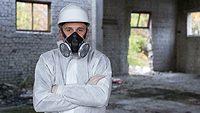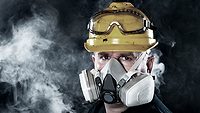EPA’s RRP Program for the Restoration Industry

Photo credit: tomazl /E+ via Getty Images
For this month’s article I’m going to switch over to the “E” side of environmental, health, and safety. The topic is lead-based paint and the regulation is the Renovation, Repair, and Painting Rule from the Environmental Protection Agency (EPA). The EPA has a very informative webpage that all restorer’s should be familiar with: https://www.epa.gov/lead/lead-renovation-repair-and-painting-program. I want to be clear that this topic is completely different than lead-based paint abatement. The intent is not to remove the lead paint (i.e. abatement), but to perform restoration work that may disturb the lead paint, create dust, and cause it to become airborne. (1) In much simpler terms, the RRP Program is about dust control.
Author’s Note: For this article, I will only cover the EPA Federal RRP Rule. Some states have adopted their own programs and Renovators should be aware if their state has a program. The Resources list at the end of the article has a link to check your State.

Lead Hazards
The hazards of lead paint have been known for years, the primary risk being to children and pregnant women. Some of the effects to children include behavior and learning problems, slowed growth, and hearing problems. Pregnant women risk premature birth and risks for the baby. (2) However, for restoration work and the RRP Rule, we are primarily concerned with lead paint becoming airborne in the form of dust and then breathed into the lungs or swallowed.
EPA RRP Enforcement
Many big box stores continue to run into problems after the 2008 introduction of the rule. In 2014, Lowe’s Companies Inc. was issued a $500,000 penalty for their contractors not following the RRP requirements. (3) The Home Depot Inc. was slapped with a fine of more then $20 million in 2021 as well as entering into a consent decree for a corrective program. (4) A Google search will show many popular home improvement shows have been fined for violations of the rule.
What does this mean for a restoration company that might not have this level of visibility? In my opinion, it shows that enforcement is taking place and the resulting public awareness will result in homeowners asking questions about lead-based paint. This increases the risk for violations for not following the rule.
Application of the Program
The easiest explanation for applying the program is that it applies to jobs that disturb painted surfaces in a child-occupied home or facility built before 1978 and visited regularly by a child under 6 years of age. (5) The work activity can include remodeling, renovation, plumbing, electrical work, and more. Given the broad range and complexity of the rule, knowledge gained in the RRP certification course is extremely valuable and applicable. Additionally, I strongly recommend using the decision logic charts in Module 3 of the initial RRP training course student manual (See the Resources section of this article).
Certification and Training
Speaking of the RRP course, there are three basic levels of certification and training.

- Lead-Safe Certified Firm: Companies that perform work that qualifies for the RRP Rule will need to apply for certification, have certified restorers on staff, and follow lead-safe practices. Firms must recertify every five years.
- Certified Renovator: This person applies and oversees the RRP Rule requirements for the certified firm. They must complete an eight-hour course, followed by four-hour refresher courses every five years.
- Worker training – Certified renovators must provide on-the-job training to workers who will be performing lead-safe practices.
Testing of Painted Surfaces
One option that Certified Renovators can use to allow them to NOT apply the Rule is testing and determination that the paint on the building components being renovated are lead-free. The testing options include:
- A certified inspector tests and determines the paint is lead-free;
- A certified renovator tests and determines the paint is lead-free with an EPA-recognized test kit;
- A certified renovator collects paint chip samples, submits them for laboratory analysis, and they are determined lead-free.
Exemptions for emergency services
The EPA Rule does allow for emergency exemption if the renovation work is a result of a sudden, unexpected event that presents a health hazard and threatens equipment or property with significant damage. There are, however, some requirements at the end of the emergency services, such as cleaning, verification, and recordkeeping. (6)
Educational Materials to Provide to People in the Building
The EPA emphasizes pre-renovation education requirements, which entail distributing a “lead pamphlet.” The requirements apply to contractors, property managers, and other who perform renovation work at qualifying buildings for compensation. (7) The pamphlet is Renovate Right guide explains the rule and its application (see the Resources section). Renovators are have very specific requirements for this pamphlet. They must get the homeowner or tentant signature or they must certify the homeowner was unavailable and leave the pamphlet under the door
What Are “Lead Safe” Practices?
To summarize very briefly, lead-safe practices are learned and practiced in the Certified Renovator course. They include, but are not limited to:

- Posting signs
- Installation of plastic drop cloth in the work area
- Covering various building features with plastic (e.g. Heating/Cooling Duct Outlets)
- Cleanup using a HEPA Vaccum
- Cleaning supplies and verification
A large portion of the student manual for the certified renovator course is dedicated to the understanding and application of the practices. (See the manual in the Resources section)
Recordkeeping Requirements
Documenting the paint testing, work practices, and cleaning is a big part of the rule requirements. The certified renovator bears much of the responsibility to perform this documentation. Fortunately, the EPA created forms and checklists that help tremendously with this. I urge renovators to reference Module 7 of the student manual (Resources section).
If it’s not obvious by now, I have barely skimmed the surface of the RRP Rule. None of the requirements are beyond the capability of a restoration company with technicians with IICRC certification. However, the requirements are very specific and have important timing related to the progress/tasks of the restoration work. Fortunately, the EPA did significant legwork prior to implementation and a Restorer has many resources to help, along with the certified renovator course. I strongly recommend every restoration company to understand the rule and dedicate time, money, and effort into compliance with the RRP Rule.
Resources:
States with EPA-Authorized RRP Programs: https://nchh.org/information-and-evidence/healthy-housing-policy/national/keystone-federal-policy/rrp/authorized-states/#:~:text=EPA has delegated authority to,Georgia, Oklahoma, and Delaware.
Small Entity Compliance Guide to Renovate Right. EPA-740-K-10-003. https://www.epa.gov/sites/default/files/2020-03/documents/small_entity_guide_9-23-11_w_new_cover.pdf
Lead Safety for Renovation, Repair, and Painting. Model Certified Renovator Initial Training Course Student Manual. EPA-740-R-09-002. https://www.epa.gov/sites/default/files/2014-05/documents/initial_renovator-student_oct2011_0.pdf
The Lead-Safe Certified Guide To Renovate Right. EPA-740-K-10-001. https://www.epa.gov/sites/default/files/2020-09/documents/renovaterightbrochurecolor.pdf
References:
- https://www.epa.gov/lead/lead-abatement-versus-lead-rrp
- https://www.epa.gov/lead/learn-about-lead
- https://www.epa.gov/enforcement/lowes-home-centers-llc-settlement
- https://www.epa.gov/enforcement/home-depot-settlement-information-sheet
- EPA Definition of Child-occupied Facility: https://www.ecfr.gov/current/title-40/chapter-I/subchapter-R/part-745/subpart-E
- Title 40, Chapter 1, Subchapter R, Part 745, Subpart #, 745.82(b): https://www.ecfr.gov/current/title-40/chapter-I/subchapter-R/part-745/subpart-E
- https://www.epa.gov/sites/default/files/2020-03/documents/small_entity_guide_9-23-11_w_new_cover.pdf
Looking for a reprint of this article?
From high-res PDFs to custom plaques, order your copy today!








